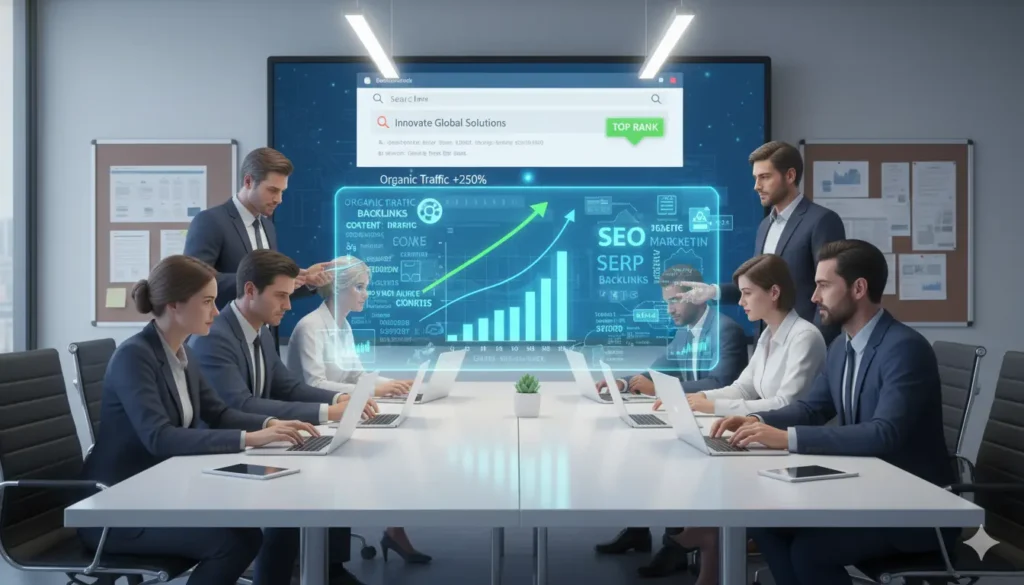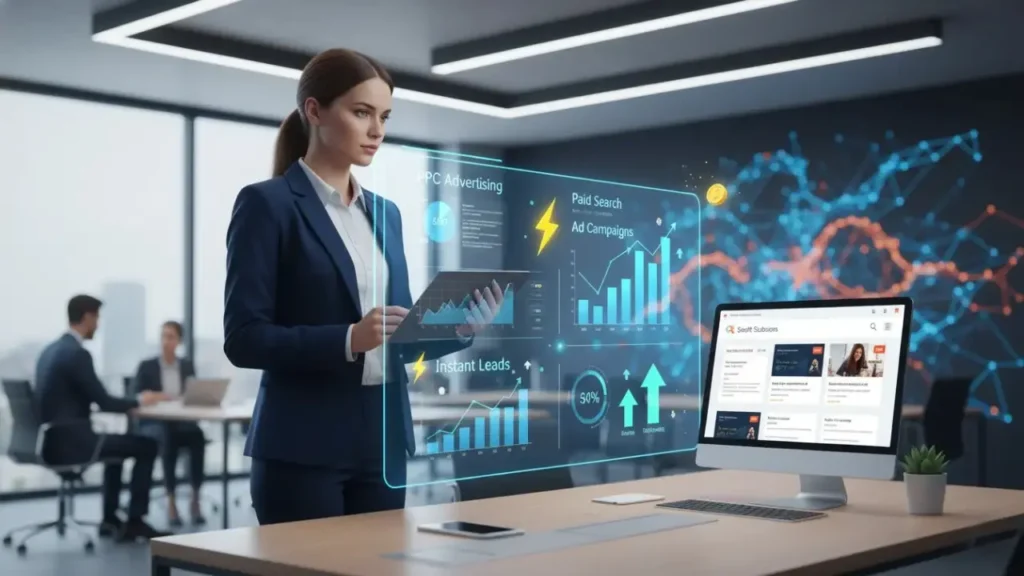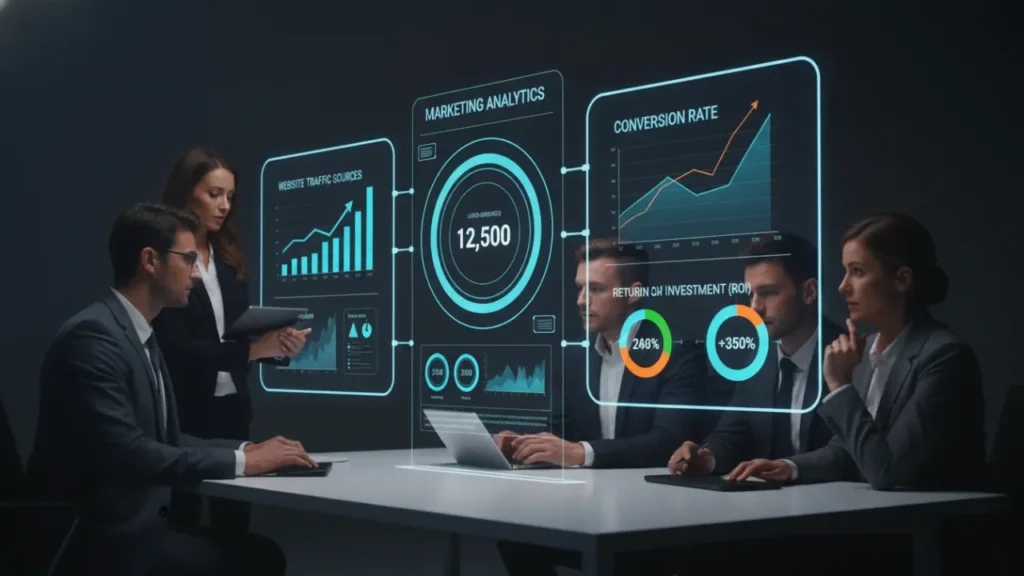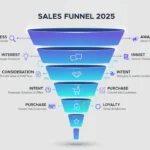What if you could show up exactly when buyers are searching, scrolling, or deciding and prove every marketing dollar worked? That’s the practical answer to how digital marketing helps business growth in 2025. Here’s the curiosity spark: most teams still treat digital like a set of campaigns. The winners treat it like a system one that turns attention into revenue with clarity, proof, and steady iteration.
This guide breaks down how digital marketing helps business at every stage from awareness to repeat purchases. You’ll see which channels fit which goals, how to connect creative to conversion, and how to measure ROI without guesswork. You’ll also get checklists, mini-examples, and KPIs you can take to your next leadership meeting.
The Short Answer: How Digital Marketing Helps Business (in One Page)
Here’s the quick, practical view of how digital marketing helps business:
- Reach the right people faster. Search, short‑form video, and social discovery let you target intent or interest precisely without guessing.
- Lower acquisition cost. SEO and content reduce dependence on rising ad costs; smart targeting trims waste.
- Increase conversion rate. Landing pages, message match, and A/B testing turn more clicks into customers.
- Measure what matters. UTMs, analytics, and CRM data link impressions to revenue with clear KPIs.
- Retain customers longer. Email and SMS automation raise repeat purchase rates and lifetime value (LTV).
- Defend your brand. Reviews, local listings, and helpful content build trust and resilience across markets.
In 2025, the compounding effect is the game‑changer: small improvements to visibility, clarity, and conversion stack together to create outsized returns.
What Changed in 2025 and Why It Matters
- Short‑form video dominates discovery and proof. The first two seconds matter more than the next twenty.
- Search lives inside social, too. People type “how to,” “best,” and “near me” directly in platform search bars.
- Zero‑click is normal. Helpful snippets (FAQs, How‑Tos, reviews, product data) often decide before a click.
- Privacy reshaped tracking. Expect modeled conversions and aggregated reporting; define ROI beyond last‑click.
- Trust beats polish. Real photos, process screenshots, measurable outcomes, and fast responses drive decisions.
Understanding these shifts helps you see how digital marketing helps business now: by being discoverable, useful, and measurable everywhere buyers actually make choices.
Strategy Framework: Audience → Offer → Channels → Content → Conversion → Measurement
A repeatable system is the real answer to how digital marketing helps business. Use this six‑step framework.
1) Audience (fit first)
- Define 2–3 buyer personas: roles, goals, friction, phrases they use.
- Map jobs‑to‑be‑done: what they want from you today vs next quarter.
- Identify where they spend time (Google, YouTube, Instagram, LinkedIn, communities).
2) Offer (make the next step obvious)
- Pick a primary call‑to‑action (CTA) per page/ad: download, book, buy, subscribe.
- Add risk reducers: free trials, refunds, before/after proof, “see it in 2 minutes.”
- Position value in outcomes, not features.
3) Channels (choose on purpose)
- Start with two core lanes (e.g., SEO + email; PPC + landing pages; Instagram + retargeting).
- Ensure channel–audience match before adding a third.
4) Content (native, helpful, repeatable)
- Create 3–5 content pillars (education, proof, comparisons, how‑to, culture).
- Build series (e.g., “3‑step Wednesdays,” “Myth Monday,” “Customer Story Friday”).
- Repurpose long pieces into short clips, carousels, and newsletter snippets.
5) Conversion (page + offer + proof)
- Align message from ad → page (headline mirrors ad promise).
- Optimize speed and mobile UX; use short forms; add social proof near the CTA.
6) Measurement (remove guesswork)
- Tag every link with UTMs; set up events and goals.
- Track by funnel stage; report decisions, not just numbers.
This framework is the backbone of how digital marketing helps business with clarity, speed, and measurable progress.
Awareness: Channels and Tactics That Earn Attention
SEO (Search Engine Optimization)

- How it helps: captures high‑intent searches; compounding visibility.
- Tactics: topical hubs, comparison pages (“X vs Y”), structured data (FAQ, Product, Local Business), Core Web Vitals.
- Why it matters: pages become “always‑on sales reps.”
PPC (Search & Social Ads)

- How it helps: captures demand now; tests messaging fast.
- Tactics: intent‑based keyword groups, exact match for control, strong message match, focused landing pages.
- Why it matters: proof of demand and unit economics in days, not months.
Social (Organic + Creators)
- How it helps: discovery, social proof, and community; accelerates trust.
- Tactics: Reels/Shorts, creator collaborations, carousels for education, “comment ‘guide’” DM flows for list growth.
- Why it matters: faster brand learning and lower friction to first action.
PR & Partnerships
- How it helps: credibility, quality links, referral traffic.
- Tactics: data stories, co‑created guides, association features.
- Why it matters: your name shows up where your buyers already trust.
Consideration: Building Trust with Proof and Education
This is where many lose momentum. Here’s how digital marketing helps business in the middle of the funnel:
- Comparison content: “X vs Y,” “Top tools for ___”objective pros/cons build confidence.
- Case studies with numbers: before/after, steps taken, timeline, and outcomes.
- How‑to videos: 30–120 seconds showing the exact steps your buyer cares about.
- Interactive tools: calculators, quizzes, and configurators anchor value to the buyer’s context.
- Email nurture: deliver outcomes, not fluff 1 tip + 1 proof + 1 CTA.
Remember: people don’t want more content; they want clarity. Make the next step obvious.
Conversion: Turning Traffic into Customers (CRO Essentials)
Improving conversion rate is the single fastest way how digital marketing helps business because every channel benefits.
Landing Page Checklist
- Message match: headline repeats ad/search promise in buyer language.
- Single purpose: one CTA; minimal navigation; no competing links.
- Trust: reviews, star ratings, client logos, certifications near CTA.
- Proof: screenshots, photos, specs, FAQ that mirrors objections.
- Mobile-first: fast (<2s), big tap targets, short forms.
- Accessibility: alt text, contrast, keyboard navigation.
A/B Testing Ideas
- Value vs pain framing in headline
- Hero image vs 30‑second explainer video
- Multi‑step form vs single page
- Risk reversal language (“Try it free,” “Cancel anytime”)
- Social proof placement (above vs below the fold)
Small wins (e.g., +20% conversion) compound across every channel.
Retention: LTV, Email, and Post‑Purchase Experiences
Acquiring is expensive; retention is where profits grow.
Email & SMS Flows
- Welcome (3–5 messages): deliver value fast; highlight best resources/products.
- Cart abandonment (2–3 touches): reminder → social proof → nudge.
- Post‑purchase (first‑time vs repeat): how‑to + review request + cross‑sell.
- Replenishment/win‑back: timed reminders; “what’s new since you last ordered.”
Community & Support
- Provide responsive social support; resolve publicly, details privately.
- Turn FAQs into carousels and short videos; reduce future friction.
- Encourage UGC and share real customer wins.
Retention is the most overlooked way how digital marketing helps business and it’s usually the most profitable.
Local and Ecommerce Specifics
Local (Map Pack & Reviews)
- Optimize Google Business Profile: category, services, hours, photos, booking links.
- Ask for reviews after positive interactions; reply to all; embed review snippets on location pages.
- Build location pages with directions, parking, team photos, and neighborhood references.
Ecommerce (Product & Category Clarity)
- Product pages: unique copy, high‑quality images, FAQs, reviews, Product + Offer markup.
- Category pages: internal links, buying guides, filter handling (canonical tags or indexable valuable combinations).
- Feed quality: titles, attributes, and images matter for both SEO and Shopping ads.
That’s how digital marketing helps business that operate in local markets or across complex catalogs: clarity + speed + proof.
Paid + Organic: Making Them Boost Each Other
- Use PPC search terms to find SEO opportunities; create pages for high‑intent queries you’re paying for.
- Send paid clicks to pages designed for conversion; Quality Score gains lower CPC.
- Protect brand terms with a small PPC budget (competitors will bid on your name).
- Repurpose top organic posts as ads; ads data reveals best hooks and CTAs.
- Use email lists to build lookalikes on social for net‑new reach.
Paid teaches you what to say; organic compounds it into durable growth.
Analytics & Attribution: Proving ROI Credibly

Answer “what worked?” with a layered approach.
Essentials
- UTMs on every owned link; consistent naming conventions.
- Analytics configured for events: scroll, clicks, form submits, purchases, bookings.
- CRM to tie leads to revenue; import offline conversions into ad platforms.
- Search Console for organic queries and page coverage.
Attribution Reality (2025)
- Platforms report modeled conversions (including view-through); analytics reports click-through.
- Compare both over time; look for directional alignment and run small lift tests (e.g., regional on/off) when possible.
- Executive‑friendly metrics: CAC, ROAS, payback, LTV/CAC, and contribution margin.
This is how digital marketing helps business conversations shift from “spend” to “return.”
KPIs by Funnel Stage (Executive Dashboard Blueprint)
Awareness
Reach, impressions, video view rate (3s, 95%), profile visits, brand search volume
Consideration
Saves, shares (DMs), comments, CTR, landing page views, time on page, scroll depth
Conversion
Leads, MQL/SQL progression (for B2B), add‑to‑cart, purchases/bookings, revenue, ROAS
Retention
Repeat purchase rate, AOV, LTV, email revenue per subscriber, churn rate
Efficiency
- CPC, CPA, CPL, conversion rate, CAC, payback period
Track weekly for operations; summarize monthly for leadership with actions taken and next steps.
Tools (Lean Stack That Covers the Bases)
- Analytics & tag management: GA4 (or equivalent), Tag Manager
- SEO: Search Console, a crawler (Screaming Frog/Site bulb), PageSpeed Insights
- PPC: native platforms + a simple Looker Studio/BI dashboard
- Email/SMS: platform with automation and revenue attribution
- Creative: lightweight editors (CapCut, Descript), Canva/Figma templates
- Review management: request and response tool (optional at small scale)
- Project/docs: a shared calendar and SOPs to keep the loop moving
Tools support process; they don’t replace it.
Mini Case Snapshots (Anonymized)
B2B Services (Lead Gen)
- Problem: Many leads; few meetings.
- Moves: Demo‑specific landing pages; “X vs Y” comparison hub; LinkedIn carousels; email nurture; CRM scoring; imported offline conversions to ads.
- Outcome: Demo conversion +46%; cost per qualified lead −32%; sales cycle −12 days.
DTC Home Goods (Ecommerce)
- Problem: Rising CPC; weak product pages.
- Moves: Shopping feed fixes; Reels/UGC for demos; PDP FAQs + Product markup; email replenishment flow.
- Outcome: ROAS +38% at flat spend; repeat purchase +21%; unsubscribe −18%.
Local Clinic (3 locations)
- Problem: Poor map pack performance, slow site.
- Moves: GBP overhaul; location pages with parking info; review requests; mobile performance fixes.
- Outcome: Map pack calls +53%; bookings +26%; direction requests +29%.
These snapshots show the accumulative power of small, correct steps this is how digital marketing helps business in the real world.
Common Mistakes and Simple Fixes
- Channel-first thinking → Start with audience and offer; then pick channels.
- Same creative everywhere → Edit for native formats; test hooks and CTAs.
- Home page landing → Build focused pages with single goals and message match.
- No UTMs or events → Tag everything; log conversions; standardize naming.
- Ignoring mobile speed → Compress images, defer scripts, simplify layout.
- Publishing without capture → Pair content with a relevant lead magnet or product CTA.
- Last-click tunnel vision → Compare platform and analytics; look for trends and lift.
- Neglecting post‑purchase → Email flows and community support increase LTV.
Fixing just two or three of these typically moves KPIs within weeks.
Conclusion: The Compounding Power of Clear, Measurable Marketing
In the end, how digital marketing helps business is simple:
- It puts you in front of the right people exactly when they’re ready to learn or act.
- It turns more of those moments into revenue with fast, focused experiences.
- It proves what worked so you can invest with confidence.
Do the small things well message match, page speed, proof, clear CTAs, UTMs and keep doing them. The compounding effect is the unfair advantage.
Want to Grow Your Business Faster with Digital Marketing? Let’s Talk.

Digital marketing isn’t just about being online it’s about attracting the right customers, generating consistent leads, and scaling your business with data-driven strategies.
At SparXcellence Ghodke’s LLP, we help businesses grow through:
✔ SEO for long-term visibility
✔ PPC ads for fast, targeted traffic
✔ Social media marketing for brand awareness
✔ High-quality content that builds trust
✔ Conversion-focused website design
✔ Analytics and reporting for measurable ROI
Get Your FREE Digital Marketing Consultation
Let our experts analyze your business and create a 2025-ready growth plan.
Book now:
https://ghodkes.com/contact-us/
FAQs
How digital marketing helps business with limited budgets?
By prioritizing two channels where your buyers are active, improving conversion rate on landing pages, and using email to protect margin through repeat sales. Small, focused efforts compound.
Which channels should we start with?
Choose based on audience and goals: SEO + email for compounding growth; PPC + landing pages for quick demand; Instagram/Shorts + retargeting for visual products; LinkedIn + YouTube for B2B; local SEO + reviews for service businesses.
How long until we see results?
Paid search/social = days to weeks; SEO/content = weeks to months; email retention = 2–6 weeks. The fastest wins typically come from landing page and messaging improvements.
How do we prove ROI?
Use UTMs and events to connect posts and ads to site behavior, import offline conversions into ad platforms, and track CAC/ROAS. Compare results to historical baselines and run small lift tests when possible.
Is SEO still worth it in 2025?
Yes. Helpful content, structured data, and fast pages create durable visibility and better conversion across channels.








